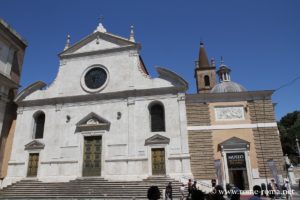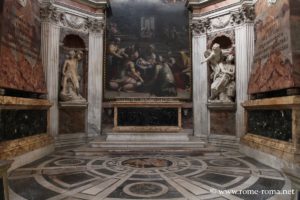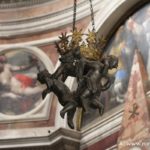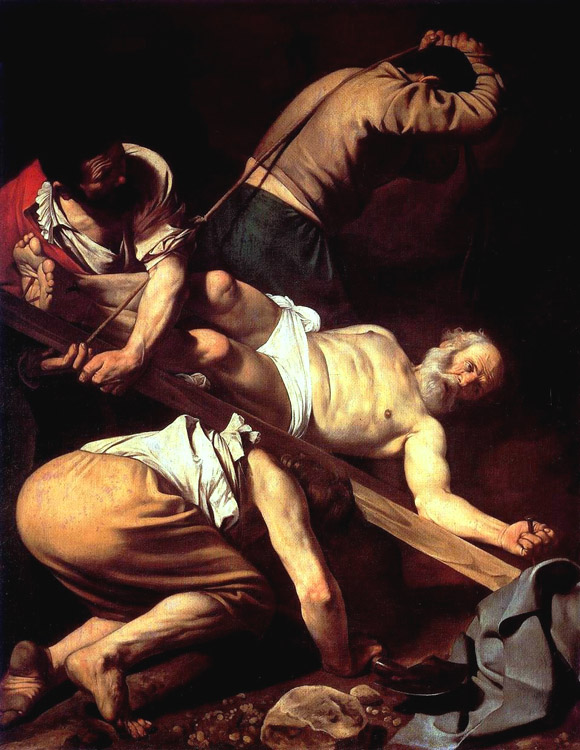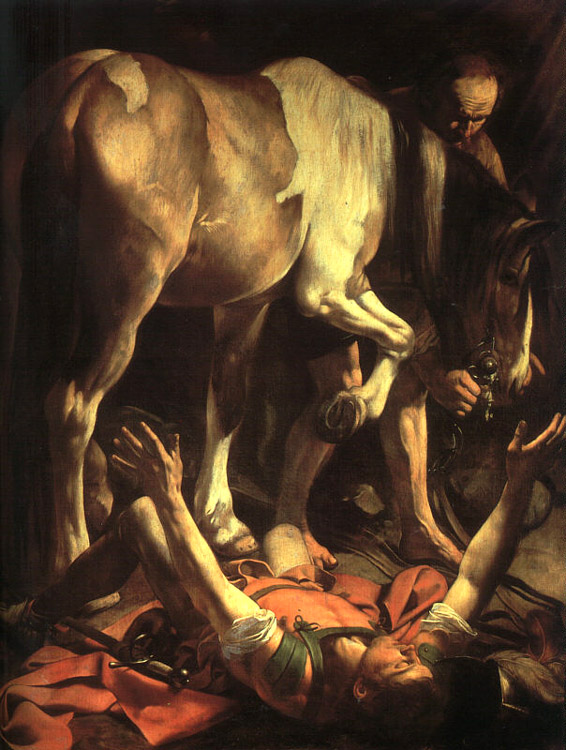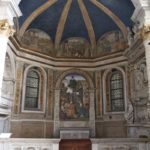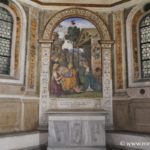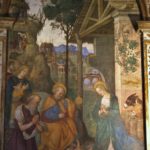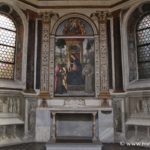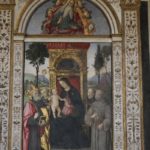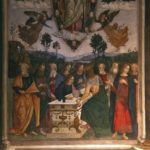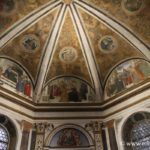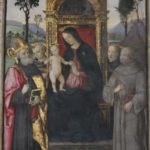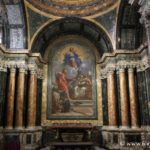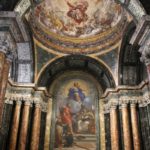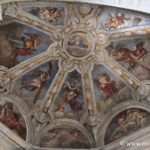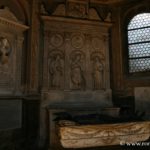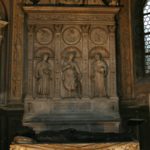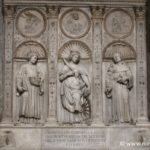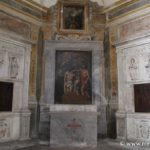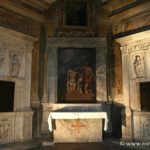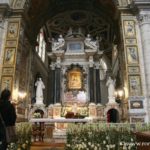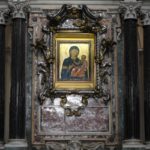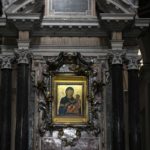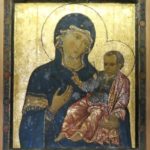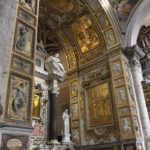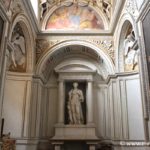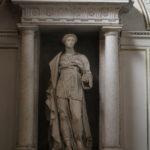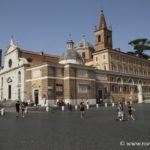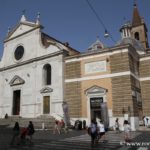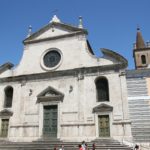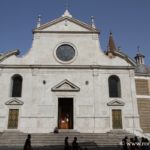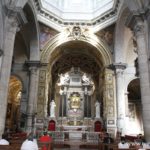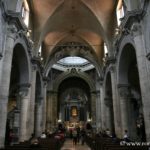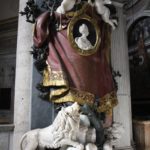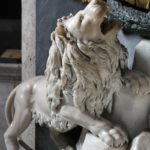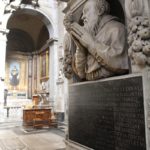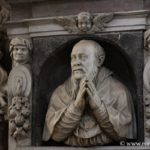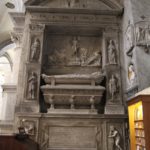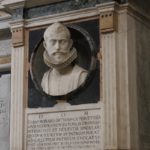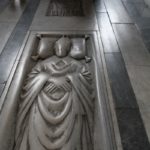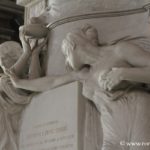The Basilica of Santa Maria del Popolo (Basilica di Santa Maria del Popolo in Italian) is one of the most important buildings of the Roman Renaissance, not only for its architectural features but also for its paintings, including two works by Caravaggio, and sculptures that make it a valuable museum of Renaissance art.
It is located on Piazza del Popolo, near the Porta del Popolo (the Porta del Popolo in Italian).
Key highlights:
- The side chapels, decorated with frescoes and paintings from the 16th century.
- The coffered ceiling and dome, remarkable for their decoration and luminosity.
- The works of Caravaggio and Raphael in the dedicated chapels.
- The façade and the square, offering a harmonious contrast between the exterior and the interior of the basilica.
Historical Overview
A first small church was built by Pope Pascal II over the Domizi tombs to, according to legend, drive away the spirit of Nero buried there. More likely, it was built to celebrate the conquest of Jerusalem at the end of the First Crusade.
The current church was founded in the 15th century under Sixtus IV, giving it its beautiful Renaissance appearance. It was modified in the 17th century by Gian Lorenzo Bernini (Bernini) under Alexander VII to give it a livelier, typically Baroque face.
General Description
The church layout is simple, in a Latin cross with three naves, corresponding to the model of Cistercian churches.
Its charming 15th-century bell tower is of a style originating from northern Italy, rarely seen in the region.
Many famous artists contributed to the decoration of the sanctuary, including Bramante, Sansovino, Pinturicchio, Mino da Fiesole, Raphael, Bernini, and Caravaggio. Two remarkable paintings by Caravaggio are preserved here: the Conversion of Saint Paul and the Crucifixion of Saint Peter.
Choir and Main Altar
The main altar was built in 1627, along with the decoration of the triumphal arch, where the stuccos depict the legend of the church’s foundation. The altar houses a 13th-century Byzantine-style icon called the Madonna del Popolo.
The choir, redesigned by Bramante at the beginning of the 16th century, preserves two masterpieces by Andrea Sansovino, the funerary monuments of Cardinals Ascanio Sforza and Girolamo Basso Della Rovere. The vault is decorated with frescoes by Pinturicchio (1508-1510).
Chigi Chapel
The most remarkable chapel is the Chigi Chapel, the second on the left, designed by Raphael for the banker Agostino Chigi, begun in 1513, and completed around 1656 with the intervention of Bernini. He created the statues of Daniel and the Lion and Habakkuk with the Angel.
Raphael designed the mosaics of the dome: God the Father, Creator of the Firmament and symbols of the sun and seven planets, the pyramid-shaped tombs, etc.
The statue of Jonah emerging from the whale, made by Lorenzetto, was also designed by Raphael.
The altarpiece is the work of Sebastiano del Piombo and Salviati.
- Habakkuk and the Angel (Bernini)
- Chigi Chapel
Cesari Chapel
The Cerasi Chapel (or the Assumption Chapel) is the first chapel of the left transept, near the altar. It houses two masterpieces by Caravaggio: the Crucifixion of Saint Peter and the Conversion of Saint Paul, from around 1601.
These paintings were commissioned by Tiberio Cerasi, treasurer to Pope Clement VIII, who had purchased the Foscari Chapel. It was renamed, and its renovation was entrusted to Carlo Maderno.
Cardinal Cerasi died before Caravaggio had completed the two works. His successors rejected the first versions of the paintings, considering them too expressive, and the artist produced two new versions.
However, these retained great intensity, with innovative stylistic solutions, such as the visual angle, the perspective of the figures, the representation of materials and light, and the humanity emerging from the ensemble of characters.
Annibale Carracci created a depiction of the Assumption of the Virgin, placed at the center.
The inner vault is decorated with frescoes by Carracci and Tacconi.
Nativity Chapel
The Nativity Chapel (cappella del presepio in Italian), also called della Rovere, is the first chapel on the right wing of the basilica, dedicated to the Virgin Mary and Saint Jerome. It is one of the finest 15th-century chapels in Rome. It houses a cycle of frescoes by Pinturicchio and his workshop (around 1488) and the funerary monuments of cardinals, including two from the della Rovere family. Scenes from the life of Saint Jerome are depicted.
The main altarpiece is an Adoration of the Child with Saint Jerome by Pinturicchio himself. The tomb of Cardinal Cristoforo della Rovere is by Andrea Bregno and Mino da Fiesole, and the funerary monument of Giovanni de Castro is attributed to Francesco da Sangallo.
- Nativity Chapel
- Pinturicchio, Nativity Chapel
- The Adoration of the Child (Pinturicchio)
Other Works and Chapels
The church also preserves some sculptures by Andrea Bregno and Bernini, including the magnificent organ supported by two bronze angels.
The side arches are crowned with statues of pairs of female saints, probably designed by Bernini.
Basso della Rovere Chapel
The Basso Della Rovere Chapel dates from the 1480s, with architecture similar to that of the Nativity Chapel. The paintings are attributed to Pinturicchio and his workshop, including the fresco above the altar of the Virgin and Child with Saints Augustine, Francis, Anthony of Padua, and a monk saint.
The left side is adorned with an Assumption of the Virgin Mary. The pedestal is decorated with monochrome trompe-l’œil paintings depicting scenes of martyrdom. The floor retains its Deruta majolica tiles.
- Cappella Basso della Rovere
- Assunzione della Vergine (Pinturicchio)
- Madonna in trono col bambino (Pinturicchio)
Cybo Chapel
Previously decorated by Pinturicchio, the Cybo Chapel was rebuilt by Carlo Fontana for Cardinal Alderano Cybo between 1682 and 1687. It is considered a major work of late 17th-century Rome for the quality of its paintings, sculptures, and marble cladding. The central painting is an Immaculate Conception by Carlo Maratta.
- Capella Cybo
Costa Chapel
The Costa Chapel, with the same architecture as the Della Rovere Chapel, was designed for the Portuguese Cardinal Jorge da Costa. The lunettes feature paintings from Pinturicchio’s school depicting the Four Fathers of the Church. The marble altarpiece is by Gian Cristoforo Romano (circa 1505), and the funerary monument of Cardinal Costa is from Andrea Bregno’s school. It also preserves the bronze and marble funerary monument of Pietro Foscari (1480).
- Costa Chapel
- Costa Chapel
- Costa Chapel
Montemirabile Chapel
The Montemirabile Chapel (named after the bishop who died in 1479) was transformed into a baptistery in 1561. The structures of the baptismal fonts and holy oil fonts were assembled in the 17th century from 15th-century fragments of a monument from Bregno’s workshop. The tomb of Cardinal Antoniotto Pallavicini on the left wall from 1501 is from the same workshop.
- Cappella Montemirabile
- Chapelle Montemirabile
Choir and Main Altar
Theodoli Chapel
This Theodoli Chapel, named after the Bishop of Cádiz Girolamo Theodoli, is an outstanding example of Roman Mannerism, with works by Giulio Mazzoni. Formerly dedicated to Saint Catherine, the altar houses a marble statue of her.
- Cappelle Theodoli e Cerasi
- Cappelle Theodoli e Cerasi
Exterior Views
Other Chapels and Works
- Abside
- Navata
- Tombe de Maria Flaminia Odescalchi Chigi
- Tombe de Maria Flaminia Odescalchi Chigi (détail)
- Tombe de Gian Girolamo Albani
- Tombe de Gian Girolamo Albani
- Tombe Bernardino Lonati
- Monumeto de Giovanni Batttista Robiano
- Monumento à Agostino Chigi
Map and address
Address : Piazza del Popolo, 12, 00187 Roma RM, ItalieIf you see this after your page is loaded completely, leafletJS files are missing.
Information
| Church of Santa Maria del Popolo Piazza del Popolo, 12, 00187 Rome |
Opening hours (to be confirmed, may vary) Monday: 4:00 PM – 7:00 PM Opening hours may vary |
Information |

